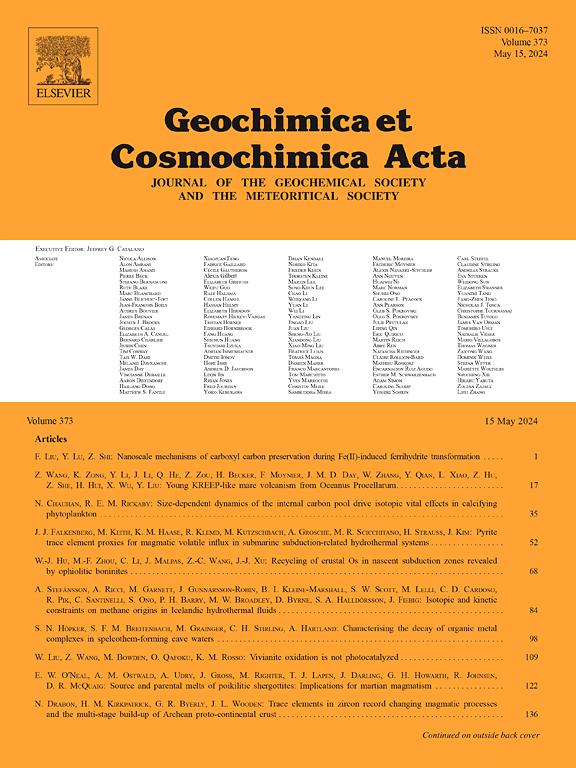金纳米粒子在铁(氧)氧化物中的吸附和粗化导致了高品位的金矿化
IF 5
1区 地球科学
Q1 GEOCHEMISTRY & GEOPHYSICS
引用次数: 0
摘要
地壳内许多热液金系统发育含富金氧化铁的高品位矿石,包括赤铁矿(α-Fe2O3)和针铁矿(α-FeOOH)。然而,这些铁(氧合)氧化物的起源及其在金富集中的作用仍不清楚。本文介绍了中国金英某高品位金矿床富金铁(氧合)氧化物在微米到纳米尺度上的详细矿物学和成分研究。研究结果表明,针铁矿和金纳米颗粒由氧化流体形成,可能是岩浆热液与富赤铁矿围岩相互作用和富氧大气水渗透的结果。针铁矿纳米颗粒通过聚集和定向附着形成针状晶体,然后通过固态转化转化为多孔赤铁矿。最初通过静电相互作用和表面吸附吸附在针铁矿表面的金纳米颗粒在针铁矿向赤铁矿转化过程中被释放。释放出的金在赤铁矿的小孔隙中重新富集,并通过聚集和奥斯特瓦尔德成熟发育成不规则的微米级颗粒。这些结果突出了以前未见的铁(氧)氧化物的形成和转化对形成与铁形成有关的某些高品位金矿化类型的金富集的影响。该研究为在各种氧化成矿环境中常见的铁(氧)氧化物中富集金纳米粒子提供了重要的新见解。本文章由计算机程序翻译,如有差异,请以英文原文为准。
Adsorption and coarsening of gold nanoparticles in iron (oxyhydr)oxides lead to high-grade gold mineralization
Many hydrothermal gold systems within Earth’s crust develop high-grade ores that contain gold-rich iron (oxyhydr)oxides including hematite (α-Fe2O3) and goethite (α-FeOOH). The origin of these iron (oxyhydr)oxides and their role in gold enrichment, however, remain unclear. This study presents detailed micrometer- to nanometer-scale mineralogical and compositional studies of gold-rich iron (oxyhydr)oxides in a high-grade gold deposit at Jinying, China. Our results show that nanoparticles of goethite and gold formed from oxidizing fluids, which might be derived from interactions between magmatic-hydrothermal fluid and hematite-rich wall rocks and infiltration of oxygenated meteoric water. Goethite nanoparticles formed acicular crystals via aggregation and oriented attachment and then transformed into porous hematite via solid-state transformation. Gold nanoparticles that were initially adsorbed on the goethite surfaces via electrostatic interaction and surface adsorption were released during the transformation of goethite into hematite. The released gold was re-enriched within the small pore in hematite and grew into irregular micron-sized particles via aggregation and Ostwald ripening. These results highlight the previously undocumented impact of the formation and transformation of iron (oxyhydr)oxides on gold accumulation in forming some types of high-grade gold mineralization related to iron formation. This study provides significant new insights into the enrichment of gold nanoparticles in iron (oxyhydr)oxides that are common in a variety of oxidizing ore-forming environments.
求助全文
通过发布文献求助,成功后即可免费获取论文全文。
去求助
来源期刊

Geochimica et Cosmochimica Acta
地学-地球化学与地球物理
CiteScore
9.60
自引率
14.00%
发文量
437
审稿时长
6 months
期刊介绍:
Geochimica et Cosmochimica Acta publishes research papers in a wide range of subjects in terrestrial geochemistry, meteoritics, and planetary geochemistry. The scope of the journal includes:
1). Physical chemistry of gases, aqueous solutions, glasses, and crystalline solids
2). Igneous and metamorphic petrology
3). Chemical processes in the atmosphere, hydrosphere, biosphere, and lithosphere of the Earth
4). Organic geochemistry
5). Isotope geochemistry
6). Meteoritics and meteorite impacts
7). Lunar science; and
8). Planetary geochemistry.
 求助内容:
求助内容: 应助结果提醒方式:
应助结果提醒方式:


